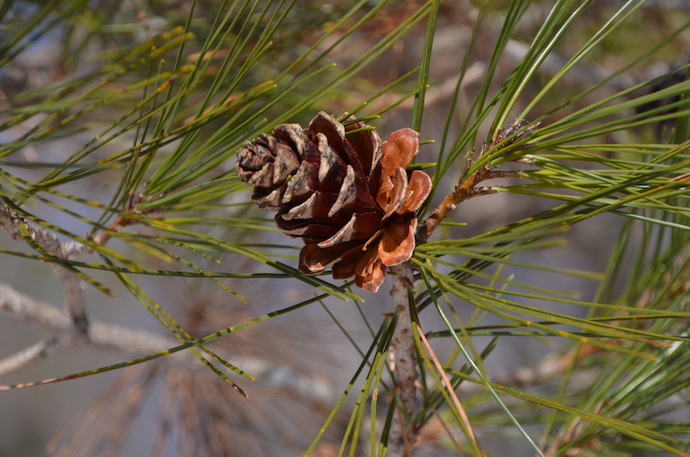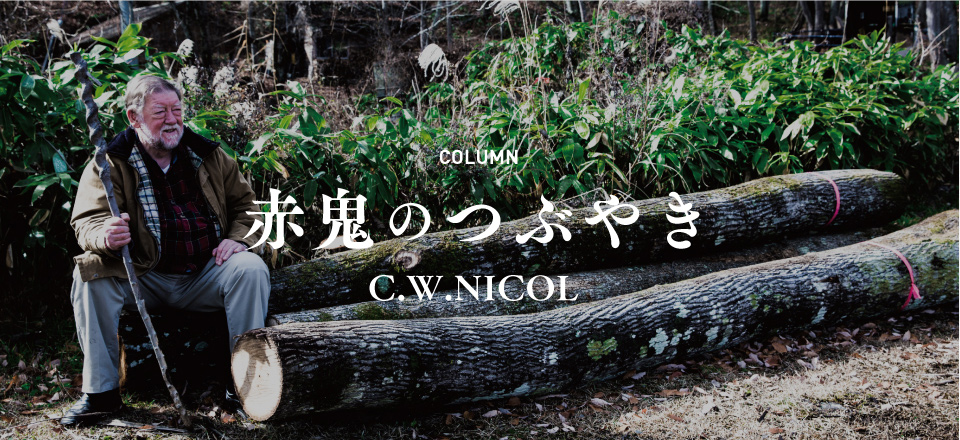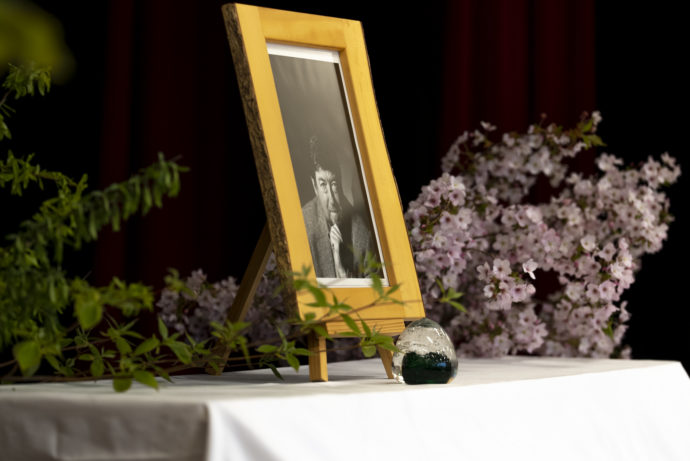Column
【赤鬼のつぶやき C.W.ニコル】アカマツ(Red Pine)

わたしにとって「特別」でない樹は一本たりともないものの、アカマツは本当にスペシャルで、アファンの森にしあわせをもたらしてくれている一種です。ラテン名はピナス・デンシフローラ、雌の松ぼっくりが黄味のかかった赤色であることから付けられた名前ですが、松ぼっくりのもとになる花の様子からこの名前が付いています。日本名「アカマツ」はもっとシンプルで、夕陽に染まる赤い幹を思わせます。
世界中に分布するアカマツですが、日本、韓国、中国の北東部や南東ロシアが原産と言われます。軽量で耐久性があり、腐りにくく、建造物に使われます。特に日本では、数百年の間、寺社建築を支え続けています。
高温で燃えることから、陶芸でも重宝され、刃物や鎌の鋳造にも使う地域もあります。カギになるのは松脂です。着火にも役立ちます。マツの樹脂は奉納などに使われるろうそくや、天然の香料、煤を集めてインクの材料にもなります。

日本に暮らしていると「マツ」という言葉を聞いただけで、あの素晴らしいキノコ、松茸を想像してしまいます。最近では松茸は韓国産、ブリティッシュ・コロンビア(カナダ)産、オレゴンやカリフォルニア(アメリカ)産が輸入されています。
日本のマツはアメリカから入ってきた松食い虫の危険にさらされています。これは大きなツノを持ったカブトムシに付いて国内に入ってきてしまうと言われ、このムシが広がると、木は生気を奪われて死んでしまいます。マツ枯れ病は酸性雨をはじめとした大気汚染で引き起こされるという説があります。木の体力を奪ううえ、松茸まで生えにくくなってしまうそうです。だから、たくさんの松茸がある山は、良い土と元気なアカマツがある証拠です。絶えていった他の種類の樹木と同じ道をたどることのないよう、アカマツにも注意を払っていくことが必要だと自分は考えています。
マツの木は栄養の少ない土でも枯れることはありません。山火事のあとに、群生して復活することがあります。
西欧、特に北米では、軽くて強いマツ材で家具を作ります。丸太にはたくさんの樹脂が含まれているので取り扱いには注意が必要です。また、わたしは松ぼっくりを集めておくのが好きで、これは着火用にストックしています。
そして20種ほどのマツの種は、人間が集めて食用にできるサイズの実が成ります。アジアで一番人気があるのはチョウセンゴヨウ(ピナス・コライエンシス)、ヒマラヤ産のチルゴザマツの種です。アメリカマツの実も輸入されています。わたしたちのアファンの森では、リスがマツの実を収穫しています。そして人間は、ここでマツタケが獲れる日を夢見ています。
2017年3月
C.W. ニコル
写真提供:C.W.ニコル・アファンの森財団
RED PINE – AKAMATSU
All trees are special, but for me the red pine, or akamatsu, is very special indeed, and I am very happy that this tree also grows in our Afan woods. The Latin name for the red pine is ‘Pinus densiflora’ which comers from the abundance of yellowish-red male cones. ‘Dense flowers’. The Japanese name is more obvious because the tree has a lovely reddish-brown bark that can glow so beautifully in a setting sun.
The red pine has been spread all over the world, but its origins were in Japan, Korea, northeast China and southeast Russia. Its timber is light, durable, strong and rot resistant, and was very commonly used in building. Red pine timber can still be seen in shrines and temples all over Japan, many several hundreds of years old.
Pine timber burns very hot, and is still used to make pottery, and in our region, to forge knives and sickles. One reason why the pines burn so hot is because of its resin, a great fire starter. Pine resin has been traditionally used in votive candles, giving off a wonderful fragrance, and the soot gathered after the burning was used to make ink.
To most of us, if we use the word ‘matsu’ we think of pine mushrooms, matsutake, a great favorite in Japan, but one which is on the decline. Nowadays, much of the pine mushrooms eaten in Japan are imported from Korea, British Columbia in Canada, and Oregon and California in the US.
Our Japanese pines are under attack from a nematode, accidentally brought in from the USA, a tiny parasitic worm now carried by a long-horned beetle. The nematode is carried into the bark by the boring of the beetle, after which it spreads, destroys the sap, and kills the tree.
Some expert have claimed that the spread of this pine-killing disease is really caused by air pollution, especially by acid rain, which both weakens the tree and hinders the production of pine mushrooms. Where you get plenty of pine mushrooms (matsutake) you have healthy soil and healthy trees. I personally also think that the pinewoods need to be carefully tended, as indeed they always were in the past.
Pine trees can thrive on poor soil however, and are one of the trees to recolonize land after forest fires.
In the west, especially North America, pine timber is popular for furniture use, because of its lightness and strength, although the timber has to be carefully treated for its abundance of resin.
I like to gather pinecones for fire starters or kindling.
Pine nuts or seeds for human use come from about twenty species of pine with seeds large enough to harvest. In Asia the most popular come from the Korean pine (Pinus koraiensis) and from the chilgoza pine from the Himalayas. American pine nuts are also imported. In our woods, it is mostly the squirrels that harvest the little red pine seeds. We have yet to fine matsutake in our woods, although we keep on hoping.
C.W.Nicol
March, 2017
Kurohime.
C.W.ニコル
作家・1940年イギリス南ウェールズ生まれ。1995年日本国籍取得。カナダ水産調査局北極生物研究所の技官・環境局の環境問題緊急対策官やエチオピアのシミエン山岳国立公園の公園長など世界各地で環境保護活動を行い、1980年から長野県在住。1984年から荒れ果てた里山を購入し「アファンの森」と名づけ、森の再生活動を始める。2005年、その活動が認められエリザベス女王から名誉大英勲章を賜る。2011年、2016年に天皇、皇后両陛下がアファンの森をご視察された。





